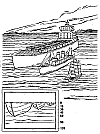The text on this site is presented as an
archival version of the script of "Ocean
Planet," a 1995 Smithsonian Institution
traveling exhibition. The content reflects the
state of knowledge at the time of the exhibition,
and has not been updated.

 Metals and slowly degrading chemicals threaten inland and coastal
waters. Toxic materials settle into sea-floor sediments where
they accumulate as hazards to organisms that live in and feed on
bottom muds. Eventually, long-lasting chemicals may enter the
food web and contaminate the fish and shellfish we eat.
Metals and slowly degrading chemicals threaten inland and coastal
waters. Toxic materials settle into sea-floor sediments where
they accumulate as hazards to organisms that live in and feed on
bottom muds. Eventually, long-lasting chemicals may enter the
food web and contaminate the fish and shellfish we eat.
NOAA scientists study reproductive problems in fish from
contaminated water in Puget Sound, 1989
Toxic materials don't always kill wildlife but they can still
cause severe damage.
photo © Joni Packard, National Marine Fisheries Service, NOAA
Click on these boxes
to identify the sources and effects of toxic materials that turn up in
polluted coastal waters





 Factory waste pipe, Widnes, Cheshire, England, 1991
Factory waste pipe, Widnes, Cheshire, England, 1991
Industrial, agricultural, household cleaning, gardening, and
automotive products regularly end up in water. About 65,000
chemicals are used commercially in the U.S. today, with about
1,000 new ones added each year. Only about 300 have been
extensively tested for toxicity §.
photo © David Woodfall/Tony Stone Images

Digging out waterways dredges up toxic materials
Because rivers wash silt downstream, and harbors and waterways
are not naturally deep enough for modern ships, we dredge them to
make them navigable. Less than 5 percent of the dredged material
contains unacceptable levels of contaminants §, but disposing
of it safely is a serious problem.
 Each year in the United States, we remove 400 million cubic yards
of sediment from channels and harbors--the equivalent of a four-
lane highway, 20 feet (6 m) deep from New York to Los
Angeles. §
Each year in the United States, we remove 400 million cubic yards
of sediment from channels and harbors--the equivalent of a four-
lane highway, 20 feet (6 m) deep from New York to Los
Angeles. §
Illustration © Bonnie Branner
 New York's harbor is naturally 18 feet deep, but most ships need
at least 45 feet to clear. § Many European superships require
a draft of 65 feet. Ship size continues to increase, so dredging
is a continuing and growing necessity.
New York's harbor is naturally 18 feet deep, but most ships need
at least 45 feet to clear. § Many European superships require
a draft of 65 feet. Ship size continues to increase, so dredging
is a continuing and growing necessity.
- early 1800s, an average packet (cargo vessel) had a draft of 15
feet
- 1930s, an average steamship had a draft of 26 feet
- 1990s, an average ship needs 45 feet, a tanker 60 feet
Illustration © Bonnie Branner

Puget Sound cleans up its act
Factories, military bases, ships, sewage-treatment plants, and
about 3 million residents contribute to toxic wastes in the urban
bays of Puget Sound, Washington. Since 1985, the Puget Sound
Water Quality Authority, a state agency, has been overseeing
efforts to clean up contaminated sediments and to control the
sources of pollution. §
 Analyzing sediment samples to classify level of contamination,
Puget Sound, 1990
Analyzing sediment samples to classify level of contamination,
Puget Sound, 1990
State sediment-management standards and federal law regulate
methods for dredging, disposing, and cleanup of contaminated
sediments. §
photo © Puget Sound Water Quality Authority
Oysters rebound after TBT ban §
TBT, or tributyl tin, is added to boat paints to kill or repel
barnacles and other nuisance organisms that foul ships' hulls.
TBT, which seeps out of the paint into the water, keeps barnacles
off, but it also affects other wildlife. In 1982, the French
banned the use of TBT on most boats. Similar regulations have
been adopted in the United Kingdom and the U.S.
In the late 1970s, oyster populations were declining in France
and the United Kingdom. Almost all the surviving animals did not
reproduce and had malformed shells. After regulations reduced
the use of TBT, oyster production increased and shell deformation
decreased dramatically.

A) Normal oyster, about 8 years old
B) Oyster with first 5 years of growth affected by TBT, followed by
3 years after TBT ban;
C) Oyster, exposed to high levels of TBT throughout 8 years of life
courtesy of Robert J. Huggett
Other Resources:
 Ocean Planet Exhibition Floorplan
Ocean Planet Exhibition Floorplan

 gene carl feldman (gene@seawifs.gsfc.nasa.gov) (301) 286-9428
gene carl feldman (gene@seawifs.gsfc.nasa.gov) (301) 286-9428
Judith Gradwohl, Smithsonian Institution (Curator/Ocean Planet)
 Metals and slowly degrading chemicals threaten inland and coastal
waters. Toxic materials settle into sea-floor sediments where
they accumulate as hazards to organisms that live in and feed on
bottom muds. Eventually, long-lasting chemicals may enter the
food web and contaminate the fish and shellfish we eat.
Metals and slowly degrading chemicals threaten inland and coastal
waters. Toxic materials settle into sea-floor sediments where
they accumulate as hazards to organisms that live in and feed on
bottom muds. Eventually, long-lasting chemicals may enter the
food web and contaminate the fish and shellfish we eat.




